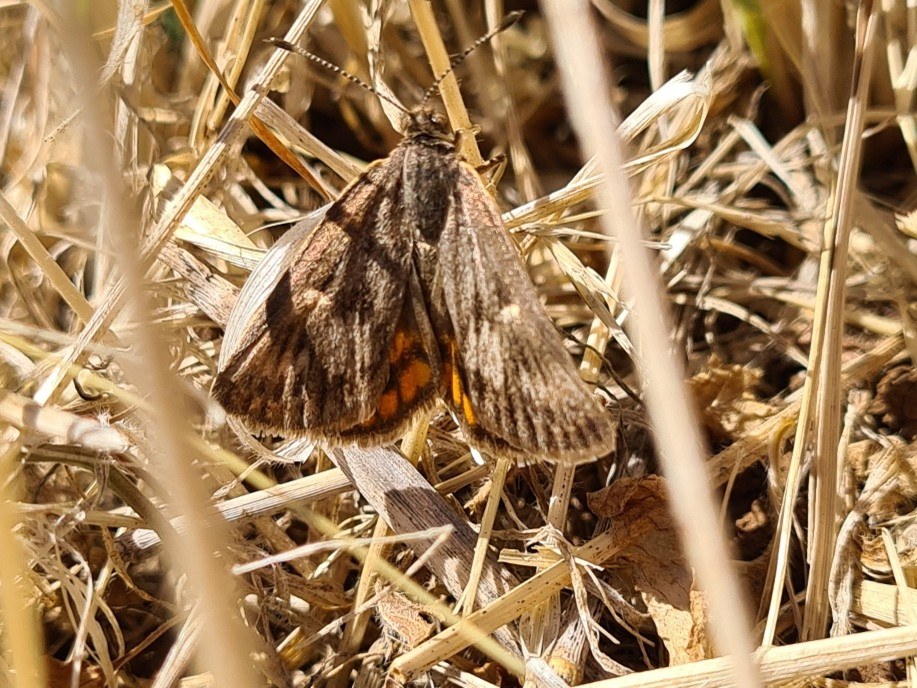Ever heard of a moth that lives for less than a week, flies in the heat of summer, doesn’t eat anything, and is so well-camouflaged it’s nearly impossible to spot?

Meet the cryptic sun-moth, an endangered day-flying moth found mostly in the grassy pockets of Adelaide’s hills face zone.
With its brown front wings, colourful orange hindwings (that it hides most of the time), and stealthy ground-hugging flight behaviour, it’s a master of disguise.
And here is the exciting part: You can help scientists learn more about it just by snapping a photo, and uploading it to iNaturalist! Whether you're a seasoned nature lover or just out for a summer walk, your sightings could make a big difference.
Discover more about this threatened species and how your photos of it can help build a better understanding of this cryptic creature.
What is a cryptic sun moth?
The cryptic sun-moth (Synemon theresa) is a threatened day-flying moth.
Thought moths were only about at night? Actually, there are a number of species that fly by day, and this particular sun-moth is generally out and about flying on super sunny, warm days.
Cryptic sun-moths are relatively small, with an average wingspan of 30 to 35 mm (males) and 32 to 36 mm (females).
The upper sides of the 2 front wings are predominantly brown with lighter brown spotted markings and a small central white spot. For females, the spotted areas on the 2 front wings are lighter brown to pale grey.
The upper sides of their back wings are orange with a row of brown spots near the outer edges, however it is common that back wings are not visible when the moths are resting on the ground or on a plant.

Where can you find cryptic sun-moths?
Cryptic sun-moths are found in the Adelaide hills face zone, in grassy areas with little tree canopy.
They could be further afield than we realise, in other native grassland patches. This is where any new observations of this moth can play a big part in understanding the species, and helping with its conservation.
There are several native grasses which sun-moth caterpillars rely on for food.
This includes:
- slender wallaby-grass (Rytidosperma racemosum var. racemosum)
- common wallaby-grass (Rytidosperma caespitosum)
- hairy wallaby-grass (Rytidosperma pilosum)
- kangaroo grass (Themeda triandra).
These native grasses are vital for cryptic sun-moths. The caterpillars rely on them for food, and they lay their eggs on the leaves or stem of these host plants. The caterpillars can even live underground and feed on the roots or the base of these host plants for 2 to 3 years.
After the caterpillars turn into moths, it is thought that the adults live for less than a week. This usually occurs from November to February. Once they’re flying (only on warm, sunny days), generally the males are quite active, looking for females or even being territorial, where the females tend to have a slower flight, looking for potential host plants.
Why are these moths so rare?
Threats to the species include:
- loss of their grassland and grassy woodland habitat
- planting of trees and / or shrubs in grassland habitats which makes the vegetation structure unsuitable
- limited and fragmented range which limits their ability to recolonise areas
- potentially inappropriate fire management regimes
- overgrazing, thatching (where grass is removed or conversely grows thickly together)
- disturbance from urbanisation
- changes of land management practices which lead to changes in grassland structure
- weeds altering habitat structure or impact on food plant availability.
Their greatest threat is modification and loss of the open grassy habitats that they call home.
Helping to raise awareness about the importance of grasslands is a big part of helping this moth.

Help us find cryptic sun-moths!
There is still so much to learn about the cryptic sun-moth, and your photos could help. We are particularly keen to better understand the range of the species and need help to locate more populations.
To help snap sun-moths, simply;
- Go for a nature walk in native grassland areas (e.g. in the Adelaide hills face zone or broader Mt Lofty Ranges) on a sunny, warm day.
- Look for cryptic sun-moths flying low to the ground in grassy areas.
- If you can, snap a picture of cryptic sun-moths and upload it to the free nature-app iNaturalist. (Note, even if you aren’t sure if it is a cryptic sun-moth, get as many good photos as you can, and experts on the app will help with identification)
- Wait patiently for experts on the app to check your photos.
- Your snap will help scientists learn more about the cryptic sun-moth!
Logging observations on iNaturalist also helps with building a better understanding of where the species calls home.
Be aware, adult cryptic sun moths may be confused with similar species, including other sun-moth species and butterflies such as common xenica (Geitoneura klugii), meadow argus (Junonia villida calybe) and skippers (a group of butterflies), but platforms such as iNaturalist can be used to upload photos for assistance with identification.
Want to know more? Check out our factsheet on all things cryptic sun-moths.